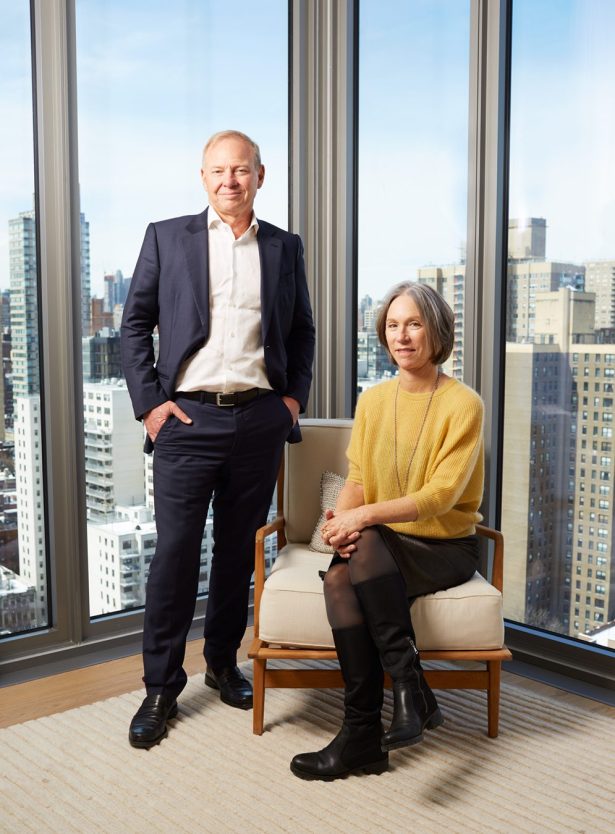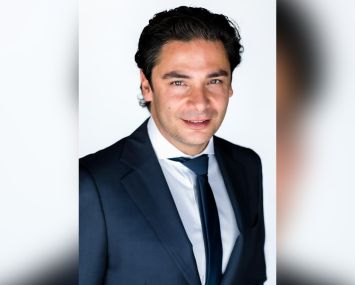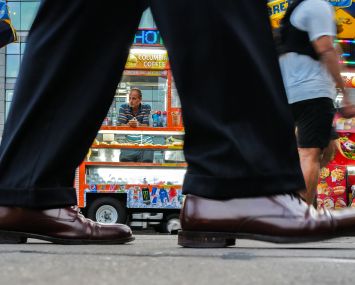Anbau’s Husband-and-Wife Duo Talk Love, Marriage and Manhattan Condos
By Larry Getlen May 2, 2018 11:00 am
reprints
The project that put Anbau, the real estate development firm run by husband-and-wife team Stephen Glascock and Barbara van Beuren, on the map was the mid-aughts development of the former InterContinental Hotel at 110 Central Park South into a 155,000-square-foot, 29-story co-op.
The already-challenging project, which involved a 100-year ground lease, came with an unusual obstacle—a last-minute payment of $4 million, on top of the $60 million they were already spending, to Donald Trump, who had been a partner in the original project.
“We were negotiating against all these other hotel developers,” Glascock said. “We made an offer, and there was one other developer who had offered to pay $4 million to him for his interest. We said, ‘we’ll pay you the same amount, but we’ll pay all cash, up front.’ That was the thing that did it. We were able to make a deal with him.”
Upper East Side-native van Beuren, 60, and Marin County, Calif.-transplant Glascock, 58, met in the architecture program at the University of Pennsylvania, and were married in 1988. They live on the Upper West Side, and have two children—son Alexander, 28, and daughter Adrianne, 26. Glascock founded Anbau, their 20-person firm, in 1988; van Beuren joined the firm in 2002.
The couple sat down with Commercial Observer in a model apartment at their latest high-rise, Citizen360 at 360 East 89th Street, to discuss their careers and their latest projects.
Commercial Observer: How did the two of you meet?
Stephen Glascock: We went to Colombia in 1986. They invited a group of planners and architects there to help design a new town to replace a town, Armero, that had been wiped out by a volcano. We had been in different classes together and met a couple of times, but we spent six weeks together there and I fell totally in love.
That’s a romantic and adventurous way to get to know each other.
Barbara van Beuren: In a hacienda with an armed guard or two! This was just as Pablo Escobar and the Medellín cartel were hitting the newspapers. It was a very uncomfortable place. The drug cartels had just shot all the Supreme Court justices, and this volcano had this mudflow that wiped out their town. It was the Wild West. The developer who brought us in asked us to dinner one night, and we arrive, and it’s like you’re in the Narcos TV series, where there’re big barbed-wire gates, and dogs, and you walk into this compound that is stunningly beautiful, but it’s like a fortress.
Glascock: It was like being in One Hundred Years of Solitude for six weeks.
Did you face any real danger?
Van Beuren: We were too stupid [to be scared]. At one point, we’re in Cartagena or some place, and we go to the bank to cash our stupid $50 travelers checks, and the guy in front of us walks up with a suitcase.
Glascock: This is Monday morning, and there are guys with suitcases opened up with hundred dollar bills stacked up. And they’re packing pistols.
How did you eventually wind up working together?
Van Beuren: I was working in architecture in Philadelphia [after college], working for developers and thinking, this is crazy. We don’t get to build what we want to build because developers are making decisions about buildings that don’t make sense.
Such as?
Van Beuren: It was all about money, especially related to design and construction. They were making decisions that had great impact on what their projects were going to be, but they didn’t understand that. They only saw dollars and cents—“this is less money so I’m going to do it.” Steve and I, early on, thought that maybe there was a way besides going up the traditional architecture track—work for a big firm, climb the corporate ladder, etc.
Was there a specific project that brought this home for you?
Van Beuren: The Cherry Hill Mall [in Cherry Hill, N.J.] I was a junior designer, and I remember sitting in a meeting with the developer, and after the meeting I thought, “This is terrible.” There was no vision. It was like, “Oh, that’s too expensive, let’s replace it with that.” It was all about using the cheapest materials and cutting corners. Back then, guys were building malls like crazy, but the idea of designing a mall was anathema.
Steve, by this point, you’d been developing a design aesthetic for a while, right?
Glascock: I’d been to Germany during high school on exchange, and was very inspired by the design of everything from washcloths to their buildings. I also spent a year after college working at an architecture firm there. That really solidified my interest and passion in not only architecture and design, but also wanting to build things as well as they were built and designed in Germany.
Van Beuren: We moved to New York in 1990 because Steve applied to Columbia to get a degree in real estate development, because [neither of us had] a finance background. We decided we wanted to develop residential, mostly because you had more of a budget there to really put design into it, because we believe that design adds value. The first driver of our projects is design. Even if people don’t understand what they’re looking at, they know it when they see it. And people will pay more for that.
Glascock: I finished the program at Columbia in 1991, and there was not a big market in real estate. The savings and loan crisis was still being worked out. So I went to work for a construction company, because I figured we may as well learn to wear as many hats as possible if we’re going to do development. I worked there for five years, and we had our second child. Barbara started her own architecture practice, mostly because she didn’t want to have to work for anyone.
Van Beuren: I wanted to control my schedule. I started it with a colleague from school. It was Van Beuren-Webb Architects. We did small Park Avenue apartment renovations. Nothing big, but I learned to set up a business.
What year was this?
Van Beuren: Probably ’92 or ’93. I only did it for about four years.
Steve, you opened Anbua in 1998. [Van Beuren joined Anbau in 2002]. What’s the significance of the name?
Glascock: Anbau means to add onto. I was inspired by the design in Germany. During college, there was a group of fellow architects who were studying architecture inspired by the Bauhaus. We would get together regularly for creative design sessions, and we called it Anbau because it was like an addition to the Bauhaus—the next Bauhaus. What it’s come to mean for us is to add onto or add value to, because each of our projects, we strive to add value at every level of the development process. It’s not just through good design, but also through taking advantage of all the zoning benefits, and using technology to create a higher level of quality, [for example].
How did the two of you decide to build a building together?
Van Beuren: It was really driven by him, because I was just doing the architecture. For probably the first project or two, it’s much more about him leading it. I phased in later because I have skill sets that were needed—architecture, design, then later, marketing.

What was the first building you bought together?
Glascock: 136 West 22nd Street. It had been a seven-story warehouse. We added two floors to the top and made it full-floor apartments, about 3,500 square feet each—35,000 square feet total. We paid, I think, $2.5 million.
How did that go?
Van Beuren: It went well. It sold out. It exceeded our expectations and was completed relatively on time—within six months of when we wanted to complete. [The project was completed in November 2001.]
Barbara, you helped out on the architecture side of things?
Van Beuren: Yes. Well, not me, but my partner in the architecture firm did the construction set. We did a model apartment, so we went to ABC Carpet and borrowed a whole lot of furniture.
They do that?
Van Beuren: They don’t anymore. We went to their warehouse and said, “Somebody will buy it. This is a great way to showcase it. Put it in a model apartment.” We sold the apartment, but we didn’t sell any furniture, so it all went right back.
Which project came next?
Glascock: A warehouse at 419 West 55th Street. It was a vacant six-story building. The challenge was selling units on a ground lease, but we knew there was a strong market for residential in that neighborhood, because a lot of office towers had just gone up in Times Square. So that went really well. I think we were selling apartments at $500 a foot or something like that. It was 39,000 square feet, 25 units and six stories, plus we added a penthouse.
The next project, 110 Central Park South, was the one that really integrated you as a firm in 2004. Tell us about that.
Van Beuren: 110 Central Park South had been the InterContinental Hotel. It was much bigger than anything we’d done before. We’d gone from doing buildings that are 40,000 or 50,000 square feet to 160,000 square feet. Everybody bidding on the building wanted to continue to operate it as a hotel, which is quite risky, at least from the land owners’ perspective, because it’s on a ground lease. Steve said we wanted to turn it into co-ops, because you can’t make condos on a ground lease. We did the numbers and convinced the owners this was a great idea, and they sold us the building, which we bought together [as members of two different firms].
Glascock: It was 26 floors originally. We added three stories. It had 64 apartments.
Tell us about the lease.
Glascock: When we started negotiating, there were 50 years left on the ground lease. At that point, it gets harder and harder to finance a project. You get to a point where there’s 30 years left, and no one will finance anything, because after another 30 years you don’t own it anymore. So we said, we’ll buy the building, but we need to extend the ground lease for another 50 years. I think we paid $60 million, something like that. It became $64 million because we had to pay Donald Trump the extra $4 million.
Van Beuren: After that, we started doing new construction. We haven’t done a renovation since.
Let’s talk about your current projects. First, the 34-story, 84-unit, 209,000-square-foot condo building here at 360 East 89th Street.
Glascock: It was originally a 50-foot lot—two 25-footers. We said, “Okay, we’ll buy this,” but then there was an opportunity to buy the next building over. We spent six months successfully negotiating the purchase of the third one. That gave us 75 feet. The third one was right next to the corner lot. So we started talking to the corner property owner, and it turns out he’d already negotiated to have that building emptied out. So we ended up buying that building. So the dominoes just kept falling, and we were able to piece together a 100-foot block.
Van Beuren: This area was hugely neglected. We try to look for areas where we see that change is coming but nobody else is buying it yet— they don’t believe it. The Second Avenue subway, which took way too long to complete, was within throwing distance of completion. It was clear it was going to be a game changer.
Glascock: We wanted to appeal to the entire range of everything, from one-bedrooms up to four-bedrooms. We have a three-story penthouse that just sold on the top of the building, and lots of family-sized apartments.
Van Beuren: SHoP is the architect, but we’ve got a few architects in our office, programming the buildings before we actually [get started]. In other words, [plotting out] how big the apartments are, what’s the unit mix, and creating floor plans according to our marketing research. We do all this ahead of time, because for architects to do their job right, they need a program. You need to give them the details—this is what we need you to design.
Glascock: Then we chose interior design firm Clodagh to do interiors compatible with those layouts, and that go with the exterior architecture of the building. We have two floors of amenities, including a library and office workspace for people who work from home, plus sound-attenuated windows and filtered fresh air. Some of those things you don’t notice or see, but when people come in, they notice it. They comment on the quietness.
You’re also selling condos at 207 West 79th Street right now.
Glascock: That’s a 13-story building with views to the north, the west towards the river and to the south.
Van Beuren: It’s in a landmark district. That’s a deterrent for people buying, but we’ve become very good at taking buildings through landmarks.
Glascock: We worked with them very closely on some custom terra cotta details. The facade for the first three floors is all limestone, and the top corners as well. It’s very appropriate for the Upper West Side, where we also live. We’re about 60 percent sold, and just starting to move people in.
What other projects do you have right now?
Glascock: We’ve got a new one in Hamilton Heights, at 153rd Street and Broadway, which is very exciting.
Van Beuren: It’s a through-block garage owned by Verizon where we’re keeping part of the garage in place, and essentially building around it. We’re building two 11-story buildings with gorgeous views up and down the Hudson River. One side is basically a park, and on the other, you’re right on the Hudson. Total square footage will be about 150,000 to 160,000 square feet.
How is that project different from your other ones?
Van Beuren: It’s efficient. The size of the apartments will be very different so price points can be within reason.
What will a one-bedroom there cost?
Van Beuren: Sub-$1 million was the goal.
Glascock: We’re really excited about this location. There were, like, four film shoots going on on different streets. Construction is just starting, and should take two years.
You’ve been in business together now for several decades. As a married couple, are you able to keep yourselves from constantly taking work home? Do you ever get away from the business?
Van Beuren: Not really.
Glascock: We get away from it. We love to travel. But speaking for myself, I love what I do, and I’m always interested in it. So to talk about work at home doesn’t bother me.


